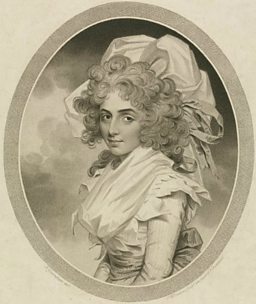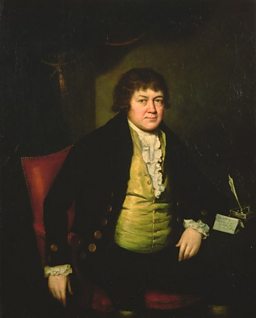Mrs Nunn plays Hamlet in Yorkshire
In Shakespeare’s time, all parts were played by male actors. But now, sensationally, female actors were establishing themselves as Shakespearean stars of the stage. Here is an example in Huddersfield of a woman playing Hamlet.
This benefit performance is for a married couple – Mr and Mrs Nunn, who appear in two extracts from Shakespeare.
-
![]()
Much ado near me
Hear more Shakespeare stories on BBC Radio Leeds
-
![]()
Shakespeare Festival 2016
The BBC celebrates the genius of the bard

Female Hamlets
By this time women were beginning to play the tragic Danish Prince and other “male” characters.
Sarah Siddons redefined the scope of the actress, and others followed suit.
One of the first to do so was the celebrated Sarah Siddons who performed Hamlet a handful of times from 1776 – and she chose the English regions to showcase her portrayal.
It appears that there is only one playbill in the British Library’s collection that refers to her Hamlet: “for this night only by desire” are the words printed on the bill flyer dated 2 Oct 1778, in Liverpool. Why did Siddons not perform it in London, home of the prestigious big two theatres?
Siddons was wary of exposing herself to criticism in the capital at a time when the morals of actresses were questioned. The provincial theatres were freer – and as an actress born and bred from strolling players, she felt at home in the English Regions.
Either way, Sarah redefined the scope of the actress, and others followed suit.
Around the same time as Mrs Nunn is delighting the spectators with her Hamlet, the American actress Charlotte Cushman is donning doublet and hose to play Romeo in England. She too, would go on to perform Hamlet.
The roll call would grow to include Sarah Bernhardt, Asta Nielsen, Angela Winkler, Frances de la Tour and Maxine Peake. Mrs Nunn was an experienced actress and by accounts had a lot of stamina and a great memory.
The Arthur Lloyd website has a note that at one point this actress had appeared as as many as fourteen characters in a week. When she appeared at the Old Theatre Royal in Bradford her takings reached £50, the highest sum ever realised in the theatre for a single benefit.
-
![]()
Maxine Peake: Hamlet Undressed
From BBC Radio 4: how does a creative team go about putting their unique stamp on the play, to create a Hamlet for Manchester, a Hamlet for now?
Theatre Royal, Huddersfield
The first Theatre Royal Huddersfield was in existence since the early 1840s and may have opened in 1841.
The building was originally built as a Lecture Hall by the Philosophical Society. It is on a site which was next door, and to the right of, the Library's entrance on Ramsden Street.
This playbill proclaims proudly: “Licensed According to Act of Parliament” - which suggests that the patent has been granted recently.
In 1859 the New Theatre Royal opened. The new Theatre was more like other Theatres in Britain with better exits and entrances to all levels and an auditorium on three levels, stalls and pit, and two galleries supported by beams and pillars.

Huddersfield entices star Shakespearean talent from the capital
Small, of a nervous disposition, and with reddish hair, Miss Sarah "Sally" Booth (1793–1867) was originally a dancer. However by 1822, the date of this playbill, she is nearly thirty and has an established career at the prestigious London theatres of Covent Garden and Drury Lane.
She was noted for her Juliet, a role that suited her girlish demeanour and pretty looks. The manager is pleased to have lured this famous London actress to his theatre where she appeared for the first time. He hopes she will be a big draw for audiences.
Sally Booth was born in Birmingham and trod the boards for the first time in Manchester at about the age of 11. She and her sister were engaged as dancers and the English provinces were her training school.
For the Irish actress Miss O’Neil was getting the kind of roles Sally Booth might have been offered.
First she worked for an irascible Irish manager called Macready, and gradually she began to play roles such as Prince Arthur in Shakespeare’s King John.
Then she went to Doncaster, where she joined the company run by the well-known Tate Wilkinson, the manager of a circuit of theatres in the North of England. There, in true fairytale fashion, she got a first break due to the illness of one of the leading actresses in the company.
She was spotted by the manager of one of the big London theatres, the Royal Circus, which was re-christened the Surrey. Her first appearance in London was in 1810 and on 23 November of the same year she played for the first time at Covent Garden.
She remained at Covent Garden where she was occasionally allowed to play the role of Juliet. But that’s where the fairytale petered out, as a rival put paid to her hopes of a career as a tragedienne, at least for a while.
For the Irish actress Miss O’Neil was getting the kind of roles Sally Booth might have been offered.
Eclipsed by O’Neil’s talent and popularity, she left Covent Garden and only returned when the actress retired from the stage.
Sally Booth was part of a trend for provincial theatre to employ actors and actresses from London
Finally it was her moment in the spotlight - an opportunity to play Cordelia to the King Lear of an actor who shared her surname but not her lineage, Junius Brutus Booth
Sally Booth claimed to be a descendant of a Lancashire actor Barton Booth, famed for his Shakespeare roles. So when she appeared with Junius Brutus Booth she asked him to add a final 'e' to his name, so as to prevent the suggestion of any connection between them.
She then acted at several London theatres: at the Olympic on 19 December 1821, at Drury Lane on 2 February 1822, and at the Haymarket and Adelphi theatres, remaining long at none.
Towards the end of the year, she was in Huddersfield and built up a reputation as a “celebrated actress” though, as this history suggests, she was a pleasing rather than an impressive performer.
She died on 30 December 1867, after giving up the stage before then. Sally Booth was part of a trend for provincial theatre to employ actors and actresses from London.
With the development of the railway this became easier and gradually, as the century progressed, theatres preferred to book from London rather than more local talent.
Shakespeare on Tour: Around Leeds
-
![]()
Shakespeare at the fair
Victorian pop-up theatres
By Royal Command
An interesting note on the playbill provides a clue to Queen Victoria’s taste in theatre:
The Performance will commence with Shakespeare's Comedy as commanded upon a late occasion, by Her most Gracious Majesty at the Theatre Royal, Drury Lane.
A popular choice of play, this note refers to a performance of the play that the Queen commanded on 12th June 1843.



About Shakespeare on Tour
From the moment they were written through to the present day, Shakespeare’s plays have continued to enthral and inspire audiences. They’ve been performed in venues big and small – including inns, private houses and emerging provincial theatres.

BBC English Regions is building a digital picture which tracks some of the many iconic moments across the country as we follow the ‘explosion’ in the performance of The Bard’s plays, from his own lifetime to recent times.
Drawing on fascinating new research from Records of Early English Drama (REED), plus the British Library's extensive collection of playbills, as well as expertise from De Montfort University and the Arts and Humanities Research Council, Shakespeare on Tour is a unique timeline of iconic moments of those performances, starting with his own troupe of actors, to highlights from more recent times. Listen out for stories on Shakespeare’s legacy on your BBC Local Radio station from Monday 21 March, 2016.
You never know - you might find evidence of Shakespeare’s footsteps close to home…
Craig Henderson, BBC English Regions
-
![]()
Shakespeare Lives
The nation’s greatest performing arts institutions mark 400 years since the Bard's death
Related Links
Shakespeare on Tour: Around the country
-
![]()
A horse! A horse! My kingdom for a horse!
King Richard III's horse White Surrey is the star of the show
-
![]()
Modern day Macbeth for Corby steel town
The adaptation encouraged younger viewers to connect to Shakespeare
-
![]()
Sarah Siddons plays Hamlet in Liverpool
Actress becomes first woman known to have played Shakespeare's Prince of Denmark
-
![]()
Child prodigy actor prepares to retire as he headlines in Newcastle
W.R. Grossmith says farewell to the stage at 11









